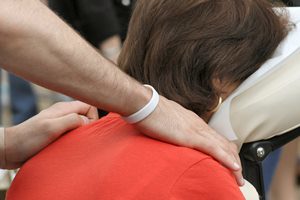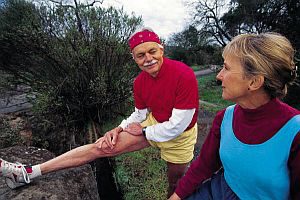Falls Among Seniors: What You Should Know

According to the U.S. Centers for Disease Control and Prevention (CDC), one in three adults over the age of 65 has a fall in any given year. Falls are the leading cause of injury-related death for adults in this age range, as well as the most common cause of trauma-related hospital admissions. More than 1.6 million older adults go to the emergency room for fall-related injuries each year in the United States. Whether you are above the age of 65, or you care for someone who is, knowing how to prevent a fall could help you save a life.
There are several risk factors that you can address to help prevent a fall. The first factor is a lack of physical activity. As adults grow older it becomes difficult to exercise on a regular basis. This leads to a decrease in strength and a loss of bone flexibility and mass. All of these factors can make falls more likely and injuries more severe.
Fortunately, there are ways for older adults to stay active. Regular exercise is the best place to start. Fifteen minutes of an exercise designed to increase bone and muscle strength should be done every other day. This can be as simple as taking a walk or going for a swim a few times a week.
The risk of falls increases when seniors do not take adequate time to carry out daily activities. It is important to stay safe and to take your time when bending over and when lifting things. Be sure to recover your balance first before taking a step when getting out of bed or a chair.
Seniors on medications may find that their balance is impaired and their mental alertness is reduced. Some medications can cause a drop in blood pressure while you are standing up, throwing you off balance. Be sure to understand all of the side effects of your medications, and be clear with your doctor about any fears you have about your balance. He or she may be able to reduce your dosage to help keep the side effects under control.
Environmental hazards are one of the biggest risk factors for senior falls. These hazards can include items on the floor that are easy to trip on, loose rugs, unsteady furniture, and poor lighting.
To reduce the risk of environmental factors causing a fall, take time to walk through the house to locate any potential hazards. Rugs can be secured with nonskid tape and throw rugs can be removed altogether. Furniture should be kept in good repair and clutter should be kept to a minimum. Finally, consider having grab bars installed to help you get up and down securely.
Falls among seniors can be frightening, but there are steps that you can take to help prevent them. By being cautious and staying in good health, seniors can increase their chances of avoiding harmful falls.
 Pain serves an important function in our lives. When you suffer an acute injury, pain warns you to stop the activity that is causing the injury and tells you to take care of the affected body part.
Pain serves an important function in our lives. When you suffer an acute injury, pain warns you to stop the activity that is causing the injury and tells you to take care of the affected body part. Retired Brigadier General Becky Halstead is no stranger to pain. She spent her entire adult life in the military, and was the first female graduate from West Point to become a general officer. She has seen battle all over the world, including in Iraq. But she has also fought her own personal battle—with fibromyalgia.
Retired Brigadier General Becky Halstead is no stranger to pain. She spent her entire adult life in the military, and was the first female graduate from West Point to become a general officer. She has seen battle all over the world, including in Iraq. But she has also fought her own personal battle—with fibromyalgia.


 What do you think about when you hear the word “massage”? If you’re like many people, you associate massage with a day of pampering at an exclusive resort spa in the mountains or at the beach. But if that’s the first picture that comes to mind, you might be missing something very, very important. That something is the therapeutic value of massage—the ways that massage can actually improve your health and well-being.
What do you think about when you hear the word “massage”? If you’re like many people, you associate massage with a day of pampering at an exclusive resort spa in the mountains or at the beach. But if that’s the first picture that comes to mind, you might be missing something very, very important. That something is the therapeutic value of massage—the ways that massage can actually improve your health and well-being. It’s no secret that some jobs are just more physically demanding and more dangerous than others. Some of the most challenging ones are obvious—combat roles in the military, fire and rescue, heavy construction and deep sea fishing are just a few that come to mind. However, when it comes to non-fatal musculoskeletal injuries, the statistics tell a very different story about occupational health and safety and about who’s most likely to get hurt on the job.
It’s no secret that some jobs are just more physically demanding and more dangerous than others. Some of the most challenging ones are obvious—combat roles in the military, fire and rescue, heavy construction and deep sea fishing are just a few that come to mind. However, when it comes to non-fatal musculoskeletal injuries, the statistics tell a very different story about occupational health and safety and about who’s most likely to get hurt on the job. Studies have shown that one of the best ways to stick to your fitness regime is to have a reliable fitness partner. Being a fitness buddy means that someone else is counting on you to make them accountable for their workout, keep them inspired and ensure that they are not alone in their quest for fitness. To be a great fitness buddy you just need to keep a few basic guidelines in mind:
Studies have shown that one of the best ways to stick to your fitness regime is to have a reliable fitness partner. Being a fitness buddy means that someone else is counting on you to make them accountable for their workout, keep them inspired and ensure that they are not alone in their quest for fitness. To be a great fitness buddy you just need to keep a few basic guidelines in mind: